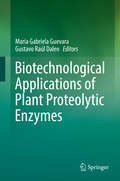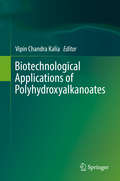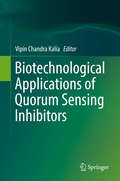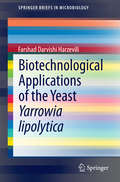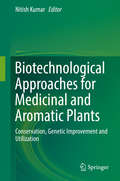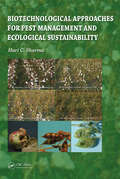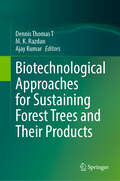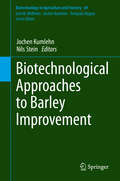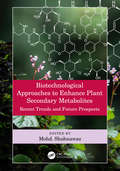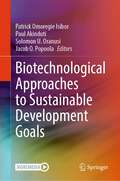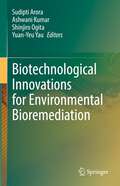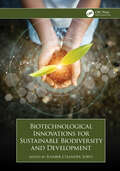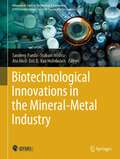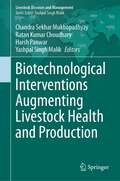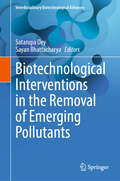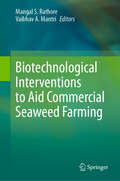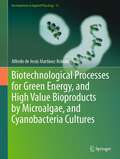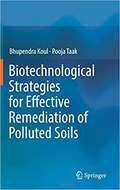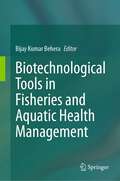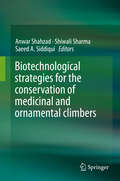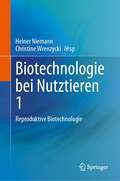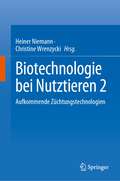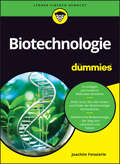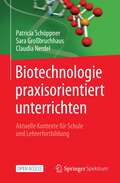- Table View
- List View
Biotechnological Applications of Plant Proteolytic Enzymes
by María Gabriela Guevara Gustavo Raúl DaleoThis book offers an overview of the diverse fields application of proteases (also termed proteolytic enzymes or proteinases), including food science and technology, pharmaceutical industries, and detergent manufacturing, reviewing the advances in the biotechnological application plant proteolytic enzymes over the last decade. In recent years, they have been the focus of renewed attention from the pharmaceutical and biotechnology industries, not only because of their activity on a wide variety of proteins but also because they are active over a range of temperatures and pHs. The main audience of this book are researchers working with plant proteases but also professionals from several industry segments such as food production and pharmaceutical companies.
Biotechnological Applications of Polyhydroxyalkanoates
by Vipin Chandra KaliaThis book presents the latest research on the uses of polyhydroxyalkanoates (PHA), introducing readers to these natural, biodegradable polyesters produced by microorganisms, their functions and applications. The individual chapters discuss the various potentials of these bioplastics, which offer an attractive alternative to non-biodegradable plastics. The book also describes the diverse medical and biomedical applications of PHAs, including their use as drug carriers, memory enhancers, and biocontrol agents, and examines their role in creating a more sustainable economy – which is the need of the hour.
Biotechnological Applications of Quorum Sensing Inhibitors
by Vipin Chandra KaliaThis book discusses the practical applications of quorum sensing inhibitors for both human and plant health. Quorum sensing inhibitors that disrupt microbial biofilms can be employed to treat bacterial infections. The book describes the various bioactive molecules that can serve as quorum sensing inhibitors to combat deadly bacterial infections, in addition to several synthetic quorum sensing inhibitors. Quorum sensing is the mechanism through which bacteria develop antibiotic resistance. Intended to provide a clearer understanding of the practical applications of quorum sensing inhibitors, the book details how the problem of antibiotic resistance can be countered through the intelligent application of quorum sensing inhibitors.
Biotechnological Applications of the Yeast Yarrowia lipolytica (SpringerBriefs in Microbiology)
by Farshad Darvishi HarzeviliDue to its ability to degrade hydrophobic substrates highly efficiently, the non-conventional yeast Yarrowia lipolytica offers various applications in the food, feed, pharmaceutical, and fine chemistry industries, as well as in environmental protection contexts such as waste treatment and bioremediation. The yeast breaks down hydrophobic substrates such as n-alkanes, fatty acids, fats, and oils, yielding valuable biotechnological products such as organic acids, extracellular enzymes, aroma compounds, bioemulsifiers, polyols, single-cell proteins, and single-cell oils. Further, Y. lipolytica is an efficient platform for the production of various heterologous proteins; more than a hundred heterologous proteins - including those of viruses, bacteria and fungi, as well as plant, animal and human proteins - have already been produced in Y. lipolytica. Since its genome has been sequenced, it is now possible to use new recombinant technology and metabolic engineering in order to improve the metabolic pathways involved in the creation of desirable metabolites and products.
Biotechnological Approaches for Medicinal and Aromatic Plants: Conservation, Genetic Improvement and Utilization
by Nitish KumarFor the majority of the world’s population, medicinal and aromatic plants are the most important source of life-saving drugs. Biotechnological tools represent important resources for selecting, multiplying and conserving the critical genotypes of medicinal plants. In this regard, in-vitro regeneration holds tremendous potential for the production of high-quality plant-based medicines, while cryopreservation – a long-term conservation method using liquid nitrogen – provides an opportunity to conserve endangered medicinal and aromatic plants. In-vitro production of secondary metabolites in plant cell suspension cultures has been reported for various medicinal plants, and bioreactors represent a key step toward the commercial production of secondary metabolites by means of plant biotechnology. Addressing these key aspects, the book contains 29 chapters, divided into three sections. Section 1: In-vitro production of secondary metabolites Section 2: In-vitro propagation, genetic transformation and germplasm conservation Section 3: Conventional and molecular approaches
Biotechnological Approaches for Pest Management and Ecological Sustainability
by Hari C SharmaDue to increasing problems occurring from massive applications of pesticides, such as insect resistance to pesticides, the use of biotechnological tools to minimize losses from insect pests has become inevitable. Presenting alternative strategies for alleviating biotic stresses, Biotechnological Approaches for Pest Management and Ecological Sustain
Biotechnological Approaches for Sustaining Forest Trees and Their Products
by Ajay Kumar M. K. Razdan Dennis Thomas TThis edited book gives an in-depth coverage of various aspects of biotechnological procedures followed by international scientists and researchers to sustain growth and improvement of forests in context of current climatic change. Forests especially trees play a crucial role in maintaining the ecological balance as well as in the functioning of natural ecosystem. More importantly, they contribute to the economic growth of a country through its products such as timber, fuel, pharmaceuticals, fibre for textile industry and edible fruits. The denudation of trees due to urbanisation of towns/cities/villages by various construction activities and industrialisation directly impact the climate change resulting in global warming, short rainfall or erroneous weather currently experienced. This book is an effort to address these problems and attempts to find out solutions using biotechnological approaches. Most of the proposed chapters cover latest information. The proposed book deals with biotechnological aspects of forest trees such as micropropagation, somatic embryogenesis, somaclonal variation, synthetic seeds, cryopreservation, disease amangement and genetic engineering. Further, applications and limitations of these approaches to improve the forest trees are discussed. The book is of relevance to teachers, students and researchers working in area of forest and plant biotechnology globally.
Biotechnological Approaches to Barley Improvement (Biotechnology in Agriculture and Forestry #69)
by Jochen Kumlehn Nils SteinThis volume offers an up-to-date overview of biotechnologically oriented barley research. It is structured into two major sections: the first focusing on current agricultural challenges and approaches to barley improvement, and the second providing insights into recent advances in methodology. Leading scientists highlight topics such as: the global importance of barley; genetic diversity and genebanks; domestication; shoot and inflorescence architecture; reproductive development; mineral nutrition; photosynthesis and leaf senescence; grain development; drought tolerance; viral and fungal pathogens; phytophagous arthropods; molecular farming; sequence resources; induced genetic variation and TILLING; meiotic recombination; Hordeum bulbosum; genome-wide association scans; genomic selection; haploid technology; genetic engineering; and whole plant phenomics. Providing comprehensive information on topics ranging from fundamental aspects to specific applications, this book offers a useful resource for scientists, plant breeders, teachers and advanced students in the fields of molecular and plant cell biology, plant biotechnology, and agronomy.
Biotechnological Approaches to Enhance Plant Secondary Metabolites: Recent Trends and Future Prospects
by Mohd. ShahnawazThousands of secondary metabolites are produced by plants to withstand unfavourable environmental conditions and are important molecules for nutraceutical, agro, cosmetic and pharmaceutical industries, etc. Harvesting of plants for the extraction of these important metabolites can threaten the plant germplasm, and various medicinally important plants are at the verge of extinction. Based on need, various methods and strategies were developed and followed by researchers from time to time to save the plant germplasm and produce important secondary metabolites efficiently to meet their growing demands. Biotechnological Approaches to Enhance Plant Secondary Metabolites: Recent Trends and Future Prospects provides a comprehensive introduction and review of state-of-the-art biotechnological tools in this field of research at global level. The methodologies are highlighted by real data examples in both in vitro and in vivo level studies. The book: • Highlights and provides overviews of the synthesis, classification, biological function and medicinal applications of the recent advancements for the enhanced production of novel secondary metabolites in plants • Provides an overview of the role of induced mutation, salinity stress and brassinosteroids impact to increase the secondary metabolic contents in plants and suggests an increase in enzymatic activity in plants could be due to various point mutations, which in turn could play a role at transcriptome levels • Discusses the significant role of endophytes to enhance the contents of plant secondary metabolites • Alternatively, suggests the urgent need to set up the standard operating procedures using hydroponics system of cultivation for significant enhancement of secondary metabolite contents • Enlists various in vitro techniques to enhance plant secondary metabolites contents using plant tissue culture approaches • Provides a systematic overview of state-of-the-art biotechnological tools CRISPER Cas9 and RNAi to enhance the plant secondary metabolite contents • Recommends CRISPER Cas9 technology over RNAi, ZFNs and TALENs because of its relatively simple and high precision method with an easily programmable tool This serves as a reference book for the researchers working in the field of plant secondary metabolites and pharmaceutical industries at global level.
Biotechnological Approaches to Sustainable Development Goals
by Solomon U. Oranusi Patrick Omoregie Isibor Paul Akinduti Jacob O. PopoolaBiotechnological Approaches to Sustainable Development Goals presents selected contributions from the 2022 International Biotechnology Conference Exhibition and Workshop (IBCEW) that cover techniques, current trends, and cutting-edge biotechnological tools for achieving sustainable development goals (SDGs). The authors explore recent advances that solve challenges related to sustainable agriculture, climate change, prevention and control of pandemics, biotechnology for a sustainable economy, and biotechnological industries and SDGs. The IBCEW aims to share knowledge, experiences, and ideas among scientists, academics, students, industry representatives, and other professionals interested in biotechnology and attaining SDGs for development in Nigeria, Africa, and globally.
Biotechnological Innovations for Environmental Bioremediation
by Ashwani Kumar Shinjiro Ogita Yuan-Yeu Yau Sudipti AroraThis edited book focuses on the application and implementation of bioremediation and other strategies to create a sustainable and healthy environment. It provides a collection of approaches to environmental biotechnology for wastewater treatment, removal of soil heavy metals, degradation of pesticides, removal of dyes, waste management, and microbial conversion of environmental pollutants. This book brings to the fore contributions of certain globally important environmental biotechnologist. Bioremediation is a popular branch of biotechnology that involves the use of living organisms such as microorganisms (microbial remediation), bacteria, fungus (mycoremediation), and plants (phytoremediation) to bind, extract, and clean up contaminants, pollutants, and toxins from soil, groundwater, and other environments. This book is of interest to researchers, scientists, and academic faculty in environmental sciences. Also, it serves as additional reading and reference material for undergraduate and graduate students as well as postdocs in environmental, agriculture, ecology, and soil sciences. National and International policy makers will also find valuable information from this book.
Biotechnological Innovations for Sustainable Biodiversity and Development
by Ranbir Chander SobtiThis book reviews the important role of biotechnological innovations in achieving sustainable development goals and conserving global biodiversity. It presents the latest biotechnological techniques used to identify and characterize various groups of plants and animals, such as genomic tools for animal identification, and DNA barcoding for precise plant characterization. It also reviews the utility of proteomics and metabolomics in enhancing our understanding of diverse species. The book also discusses responsible development and sustainable utilization of bioresources, including strategies for conserving and managing bioresources, bioprospecting for novel biodiscoveries, and sustainable agricultural practices to preserve agrobiodiversity. Further, the book addresses the pressing challenges faced by biodiversity, including the far-reaching effects of climate change, the threat posed by invasive species, the consequences of pollution on biodiversity degradation, and the interplay between diseases and biodiversity decline. Toward the end, the book analyzes the impact of environmental degradation on biodiversity and explores emerging technologies in biodiversity conservation, focusing on genetically modified organisms (GMOs). The book will interest scientists, researchers, policymakers, environmentalists, academics, and students involved in biotechnology, ecology, genetics, and conservation biology.Key Features: Discusses cutting-edge biotechnological innovations for biodiversity conservation Presents cutting-edge biotechnological techniques for identifying and characterizing selected groups of plants and animals Addresses critical environmental challenges such as climate change, invasive species, and pollution
Biotechnological Innovations in the Mineral-Metal Industry (Advances in Science, Technology & Innovation)
by Sandeep Panda Ata Akcil Eric D. Van Hullebusch Srabani MishraThe book presents the most advanced biotechnological information with respect to microbial applications in the treatment of mineral-metal bearing wastes. With growing interest in practical industrial applications of biomining microbes, of late, a lot of research has been devoted towards exploring their biotechnological potential for processing wastes derived from both primary and secondary resources for metal recovery. The chapters in the book present compiled information on several aspects of this exciting area of mineral biotechnology, that include fundamental, applied, bioprocess engineering and environment in separate chapters. These chapters provide updated information on the microbe-mineral interactions; resource specific bioleaching covering base, precious and rare earth elements leaching from primary and/or secondary resources; processing of leach solutions through biosorption, biomineralization, bio-electrochemical systems for resource recovery; treatment of mine waters, engineering and scale-up aspects of bioreactor systems for bioleaching of specific wastes and environmental challenges related to bio-mining. The book provides a unique platform for the dissemination of the state-of-the-art research on mineral biotechnology and serves as a bridge between academia and industry. Authored by well-renowned experts, it is an appropriate reference for graduate students, scientists, engineers, environmentalists working in the area of mineral biotechnology and industrial technologies.
Biotechnological Intervention in Production of Bioactive Compounds: Biosynthesis, Characterization and Applications (Sustainable Landscape Planning and Natural Resources Management)
by Jyoti DeviThis book provides an overview of the state of our understanding regarding the biosynthesis of bioactive compounds from plant and microbial sources. Additionally, examples of how these compounds have been used in food, agriculture, and human health are provided, as well as the biotechnological approach for screening and characterizing bioactive compounds. In the pharmaceuticals, nutraceuticals, and agrochemicals industries, bioactive molecules are crucial to the production of high-value products. The discovery of bioactive chemicals from diverse sources has supported their use as medications, functional food ingredients, herbicides, and insecticides due to their medicinal advantages, nutritional importance, and protective impacts in healthcare and agriculture. The systematic investigation of biologically active products and the prospective biological activities of these bioactive compounds, comprising their medical uses, standardization, quality control, mode of action, and possible biomolecular interactions, are among the greatest sensational expansions in modern natural medication and healthcare. This book is a useful resource for graduate and undergraduate biomedical chemistry and agriculture students who are interested in learning more about the possibilities of bioactive natural products. This book is useful to researchers in a variety of scientific domains where natural products are important.
Biotechnological Interventions Augmenting Livestock Health and Production (Livestock Diseases and Management)
by Chandra Sekhar Mukhopadhyay Ratan Kumar Choudhary Yashpal Singh Malik Harsh PanwarThis book comprehensively discusses the applications of molecular genetics, functional and structural genomics, and proteomics vis-a-vis bioinformatics, artificial intelligence, and robotics in livestock healthfulness and productivity. It reviews the biotechnological approaches in veterinary sciences for increasing productivity and resistance to disease. The book emphasizes the approaches based on artificial intelligence to analyze the data collected on animals, pathogens, and their environment. It underscores artificial intelligence applications in disease diagnosis, epidemiological studies, and detecting biological phenomena, including heat-detection, pregnancy, docility, and infections. Further, the book examines the genomics and proteomics approaches for understanding the gut microbiota and the role of pathogen-host interactions in animal health and disease. Lastly, it explores both pathogenic and non-pathogenic microbial transfer between humans, animals, and the environment across one health spectrum.
Biotechnological Interventions in the Removal of Emerging Pollutants (Interdisciplinary Biotechnological Advances)
by Satarupa Dey Sayan BhattacharyaThis book focuses on the most recent developments in bioremediation techniques, exploring how microorganisms can break down different pollutants and the future potential of bioremediation to reduce global pollution levels. It examines the impact of various emerging pollutants on the environment and the health of living organisms while highlighting recent advancements in bioremediation methods needed to degrade these pollutants. Addressing both inorganic and organic compounds from industrial and anthropogenic activities, including personal care products, endocrine disruptors, and pharmaceutical products, this book tackles pollutants that escape conventional water treatment processes, contaminating groundwater, soil, sediments, and oceans. The chapters also cover topics such as the toxicity and health impacts of emerging pollutants, ecotoxicological effects of nanoparticles, policies related to emerging pollutants, technologies for their detection, and technological aspects of their fate during wastewater treatment. Readers will find a comprehensive examination of the roles of microbes in bioremediation, including the elimination, degradation, detoxification, and immobilization of pollutants. The book also introduces enzyme biotechnology as a cost-effective, low-energy, eco-friendly technology for treating various pollutants. Furthermore, it discusses the combination of physical treatment and nanotechnology for sustainable pollutant removal. This book serves as a valuable resource for policymakers aiming to develop effective environmental regulations, educators seeking comprehensive educational material, researchers looking to expand their knowledge on advanced bioremediation techniques, climate change scientists dedicated to mitigating pollution, and undergraduate and graduate students studying agriculture, forestry, ecology, soil science, or environmental sciences.
Biotechnological Interventions to Aid Commercial Seaweed Farming
by Mangal S. Rathore Vaibhav A. MantriThis edited book focuses on various research topics and constraints over the seaweed sector’s sustainable development. Seaweed potentially contributes to multiple Sustainable Development Goals and thus there is a growing interest in seaweeds sectors for various industrial and ecosystem services. This book particularly focuses on the biological and biotechnological processes to aid the large-scale commercial seaweed farming. Developing quality material, disease resistance and heritable improvements in the existing germplasm sourced from wild populations, protoplast and callus-based technologies, and germplasm preservation are the major focus areas of the book. The information and knowledge provided by this book would facilitate evidence-based policymaking and sector management in seaweed development at the national and global levels. The seaweed sector has already been established or identified as sunrise sector in Asian, American, European and African countries. In these nations, this volume will act as valuable reference material for marine-sector professionals and government representatives as well.
Biotechnological Processes for Green Energy, and High Value Bioproducts by Microalgae, and Cyanobacteria Cultures (Developments in Applied Phycology #13)
by Alfredo de Jesús Martínez-RoldánMicroalgae and cyanobacteria are a very diverse group of photosynthetic microorganisms with many applications. Some of them are related to the accumulation of molecules involved in specific metabolic pathways such as pigments, fatty acids, polyunsaturated fatty acids, carbohydrates, amino acids, etc. Also, there are uses of the biomass related to the exploitation of physiological necessities such as the absorption of essential nutrients (the removal of nitrogen and phosphorus from wastewater, the capture of CO2 from the fixation of nitrogen, etc.). Nevertheless, the evaluation in financial and life-cycle aspects is necessary to ensure the industrial application of the processes. The objective of the book is to analyze innovative applications of microalgae and cyanobacteria to develop environmental-friendly processes for removal of pollutants, wastewater treatment, production of high-value products or bioenergy, and finally evaluate the feasibility of the processes both ineconomic and sustainability aspects.
Biotechnological Strategies for Effective Remediation of Polluted Soils
by Bhupendra Koul Pooja Taak<p>This book presents a comprehensive collection of various in situ and ex-situ soil remediation regimes that employ natural or genetically modified microbes, plants, and animals for the biodegradation of toxic compounds or hazardous waste into simpler non-toxic products. These techniques are demonstrated to be functionally effective in connection with physical, chemical, and biological strategies. <p>Soil and water contamination through heavy metals, hydrocarbons and radioactive wastes is of global concern, as these factors have cumulative effects on the environment and human health through food-chain contamination. The book discusses the utilization of algae, plants, plant-associated bacteria, fungi (endophytic or rhizospheric) and certain lower animals for the sustainable bioremediation of organic and inorganic pollutants. In addition, it explores a number of more recent techniques like biochar and biofilms for carbon sequestration, soil conditioning and remediation, and water remediation. It highlights a number of recent advances in nanobioremediation, an emerging technology based on biosynthetic nanoparticles. Lastly, it presents illustrative case studies and highlights the successful treatment of polluted soils by means of these strategies.</p>
Biotechnological Tools in Fisheries and Aquatic Health Management
by Bijay Kumar BeheraThis edited book is focused on SDG 14: life below water. This book covers all aspects of fish biotechnology and health management. A detailed description is provided of CRISPR Cas9 technology application in the development of superior variety of fish with better growth, disease resistance, etc., accompanied by numerous helpful photographs and schematic diagrams. In addition, recent developments in nanotechnology and its application in fisheries production enhancement have been discussed. Further, topics includes, probiotics, immunostimulants, fish genetic markers, bioremediation, metagenomics, transgenerational immune priming, application of cell culture in fisheries and nano-biosensor application on fish disease diagnosis, pollution monitoring, etc. are provided in details. . The book is helpful for researchers, teachers, students, farmers, and entrepreneurs in utilizing the knowledge on recent advancements in different aspects of fish genetics and biotechnology for future research and aquaculture production enhancement.
Biotechnological strategies for the conservation of medicinal and ornamental climbers
by Anwar Shahzad Shiwali Sharma Saeed A. SiddiquiThe book provides an overview on adoption of biotechnological approaches for the conservation, micropropagation, synseed production of various medicinal and ornamental climbers. The work includes a brief chapter on evolution and diversification of climbers. Other chapters give insights on protocols for in vitro propagation and synseed production of selected threatened medicinal and ornamental climbers. Informative chapter on the production of bioactive compound and their enhancement through genetic transformation and elicitation have been incorporated to cover latest advancement in the field of plant biotechnology. This book also explores the use of molecular marker technique for the desired improvement/magnification of medicinal and aesthetic value of climbing plants.
Biotechnologie bei Nutztieren 1: Reproduktive Biotechnologie
by Heiner Niemann Christine WrenzyckiDieses zweibändige Lehrbuch bietet einen umfassenden Überblick über das weite Feld der Tierbiotechnologie mit besonderem Schwerpunkt auf der Reproduktion und Zucht von Nutztieren. Der Leser wird mit einer Vielzahl modernster Technologien und neuer genetischer Instrumente und deren Anwendungen in der Tierproduktion vertraut gemacht. Außerdem werden ethische und rechtliche Aspekte der Tierbiotechnologie erörtert und neue Trends und Entwicklungen auf diesem Gebiet kritisch bewertet. Das zweibändige Werk ist ein Muss für Doktoranden, fortgeschrittene Studenten und Forscher auf dem Gebiet der Veterinärmedizin, Genetik und Tierbiotechnologie.Dieser erste Band befasst sich hauptsächlich mit künstlicher Befruchtung, Embryotransfertechnologien bei verschiedenen Tierarten und der Kryokonservierung von Eizellen und Embryonen.
Biotechnologie bei Nutztieren 2: Aufkommende Züchtungstechnologien
by Heiner Niemann Christine WrenzyckiDieses zweibändige Lehrbuch bietet einen umfassenden Überblick über das weite Feld der Tierbiotechnologie mit besonderem Schwerpunkt auf der Reproduktion und Zucht von Nutztieren. Der Leser wird mit einer Vielzahl modernster Technologien und neuer genetischer Instrumente und deren Anwendungen in der Tierproduktion vertraut gemacht. Außerdem werden ethische und rechtliche Aspekte der Tierbiotechnologie erörtert und neue Trends und Entwicklungen auf diesem Gebiet kritisch bewertet. Das zweibändige Werk ist ein Muss für Doktoranden, fortgeschrittene Studenten und Forscher auf dem Gebiet der Veterinärmedizin, Genetik und Tierbiotechnologie.Dieser zweite Band ist den genetischen Werkzeugen der Tierbiotechnologie gewidmet, wie dem somatischen Klonen, transgenen Technologien und der Anwendung von Stammzellen in der Tierzucht. Auch ethische und rechtliche Aspekte werden erörtert.
Biotechnologie für Dummies (Für Dummies)
by Joachim FensterleAm Anfang war das Bier! Biotechnologie ist ein spannendes Thema, aber auch vielschichtig und manchmal kompliziert. Dieses Buch hilft Ihnen, wenn Sie einen Kurs in Biotechnologie besuchen oder sich einfach so für das Thema interessieren. Joachim Fensterle erklärt Ihnen die Grundlagen und Methoden von Biotechnologie, führt Sie in die Bioverfahrenstechnik ein und ebenso in die industrielle und mikrobielle Biotechnologie. Zahlreiche über QR-Codes ansteuerbare Videos zum Buch helfen Ihnen, das Gelesene zu visualisieren und Ihr Wissen zu festigen. So ist dies eine umfassende, verständliche und bisweilen amüsante Einführung in die Biotechnologie. Sie erfahren Was Sie über Pflanzenbiotechnologie wissen sollten Wie es um die Nachhaltigkeit in der Biotechnologie steht Wie Sie Bioinformatik und Data Science nutzen Was die pharmazeutische Biotechnologie heutzutage leistet
Biotechnologie praxisorientiert unterrichten: Aktuelle Kontexte für Schule und Lehrerfortbildung
by Claudia Nerdel Patricia Schöppner Sara GroßbruchhausIn diesem Open Access Buch finden Sie Anregungen für die praktische und schülergerechte Umsetzung molekularbiologischer Methoden an ausgewählten Themenbeispielen für den Biologieunterricht. Biotechnologische Methoden wie die DNA – Analyse werden an Schulen hauptsächlich theoretisch unterrichtet und nicht experimentell erarbeitet. In einem Exkurs zu der Umsetzung eines Schüler*innen Seminars in einem S1 – Labor zeigen wir beispielhaft, wie ein längerfristiges Kooperationsmodell zwischen Schule und Universität gelingen kann. Die praktische Umsetzung kann dabei sowohl das Verständnis für komplexe Themen sowie biologische Basiskonzepte fördern, die sich mithilfe molekularbiologischer Methoden bearbeiten lassen, als auch das wissenschaftsmethodische Verständnis schulen und somit tiefere Einblicke in den Berufsalltag eine*r Laborant*in bzw. Wissenschaftler*in geben. Darüber hinaus findet man konzeptuelle Ideen für die Lehrerbildung und -fortbildung, damit sich auch (angehende) Lehrkräfte bei der Vermittlung und praktischen Umsetzung dieser Inhalte sicher fühlen bzw. Dozierende an Universitäten frühzeitig die Bedürfnisse einer modernen Lehrerbildung im Unterrichtsfach Biologie erkennen und berücksichtigen können. Alle hier vorgestellten Arbeitstechniken und Experimente sind so konzipiert, dass sie ohne zusätzliche Sicherheitsregularien außerhalb von professionellen Forschungslaboren an Schulen durchgeführt werden können.
